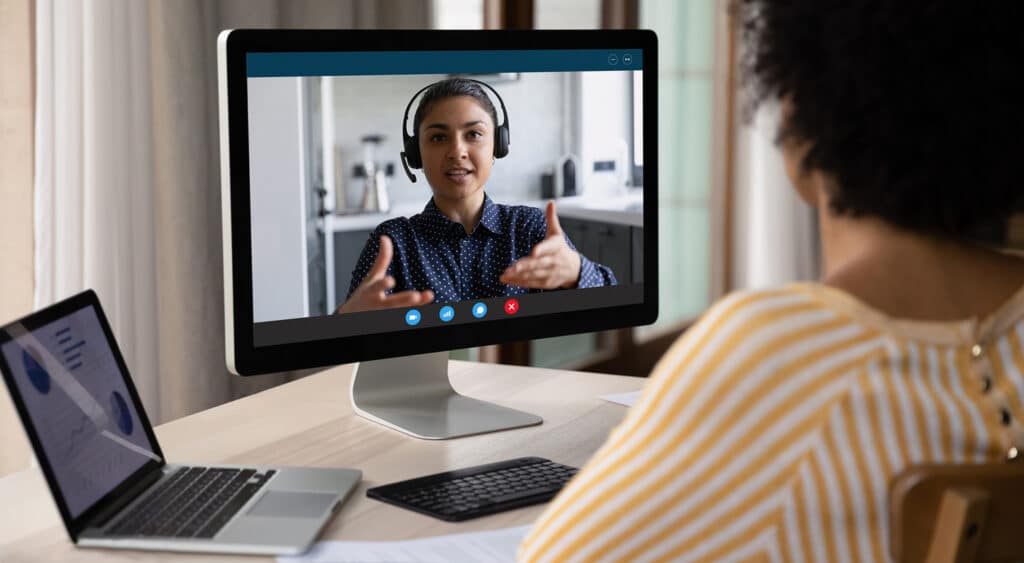What IT professionals need to know about video interviewing
In recent years, a rising number of companies have started to use video interviews as a recruitment tool. And while remote interviewing might sound simple for the tech savvy, as an IT professional in particular, you’ll need to be properly prepared in order to make a lasting impression on the recruiter or hiring manager.
Two types of video interviews
There are two types of video interviews. The traditional video interview is a live, online meeting where you interact with a hiring manager in real-time using a teleconferencing platform. It is often used after you have passed the initial résumé and phone screenings.
The second type is the pre-recorded interview in an app. Instead of interacting with a “live” person, you respond to a series of questions that appear on your screen. Many companies use the pre-recorded video interview as an early screening tool in the first or second round of the recruitment process. This type of interview offers you the opportunity to make a positive impact with your professional persona, presentation and knowledge.
Preparing for your video interview
When you receive your first invitation to a video interview, you might initially be intimidated. Preparing properly can help increase your on-screen interviewing skills—and your confidence. Keep the following pointers in mind:
Take the video interview seriously. Even if it is pre-recorded, approach it like an in-person meeting, and strive to be as professional as possible.
Prepare for technical questions. Research the job requirements before the interview, and make sure you can speak accurately and confidently about the technical aspects of the position. Review terminology, and brush up on relevant programming languages—and if applicable, tools—so you can demonstrate a good comprehension of the fundamental requirements of the job. If you are a coder, you can use Pramp to practice online coding interviews with peers. Additionally, you can search common interview questions and user-provided answers for the position by searching on Glassdoor.
Be ready to ace a skills test. A hiring manager for a tech job will want to see proof of your skills. For example, you may be asked to code a simple app, de-bug a piece of code, or create an array. Most companies will require you to do this in a timed whiteboard test so they can see the steps of your process. Practice ahead of time by creating challenges for yourself to complete in a short period of time, such as 45 or 60 minutes.
Know your work history. Go over your résumé point by point, and find ways to speak accurately and positively about your work experience and accomplishments. Always keep in mind that employers want to know what value you can bring to their company, so if you can quantify the results of your contributions to a company or project, do so.
Create reference notes if necessary. It is perfectly acceptable to have some reference notes on hand. However, make sure that they are not in view, and only glance at them when necessary.
Practice speaking about your qualifications in a way non-technologists can understand. Depending on where you are in the interview process, you might not be speaking with an IT professional who understands tech terminology. You will score extra points if you can explain your work experience and accomplishments in a way that business professionals will understand.
Find a quiet, well-lit place to conduct your interview. It is best to use your home office or another quiet room where you will not be disturbed or distracted.
Check the lighting. The interviewer should be able to see you properly, so make sure your face is well-lit. Avoid sitting in front of a window or lamp.
Ensure you have a dependable high-speed Internet connection. It is best to use a private Internet connection. Avoid public Wi-Fi connections, and if you normally use a VPN, make sure to use a server with a low load so your connection does not time out.
Make sure your hard- and software are functioning properly. Test the app you will be using. In addition, check that your device’s video and audio are in good working order.
Mute all alerts on your device. Either mute or switch off alerts and reminders that could distract you during the interview.
Dress the part. If you are not sure about the dress code, it is best to choose business attire instead of casual or business casual. Give some thought to how your clothes will appear on-screen. For example, a striped shirt could cause a visually distracting effect for the interviewer, so when in doubt, opt for plain colors. Do not make the mistake of only dressing “from the waist up.” You never know when you might have to stand up to fetch something.
Practice your on-camera presentation skills. Finally, take some time to practice being on-screen. You can simply record yourself talking to the camera on your device, or you can use an app like Talview or Interview4.me that allows you to practice the presentation aspect of video interviewing. Review your recording to see whether you are looking into the camera, smiling and enunciating clearly.
Just like with a normal job interview, preparation is key. Take the time to get comfortable with the ins and outs of video interviewing, and you will be one step closer to receiving the job offer you want.
Sources:
https://www.boston.com/jobs/job-doc/2017/03/15/video-interviewing-is-here-to-stay
http://www.informationweek.com/strategic-cio/team-building-and-staffing/video-interviews-6-mistakes-to-avoid/d/d-id/1297729
http://greenjobinterview.com/2015/06/how-to-answer-the-10-most-popular-video-interview-questions/
http://blog.talview.com/free-video-mock-interview-app
http://portal.interview4.me
https://www.pramp.com/#/
https://www.glassdoor.com/Interview/index.htm
View Related: Interviewing Video
Find your next job
Discover thousands of temporary, full-time, and remote jobs for beginning and experienced job seekers.


